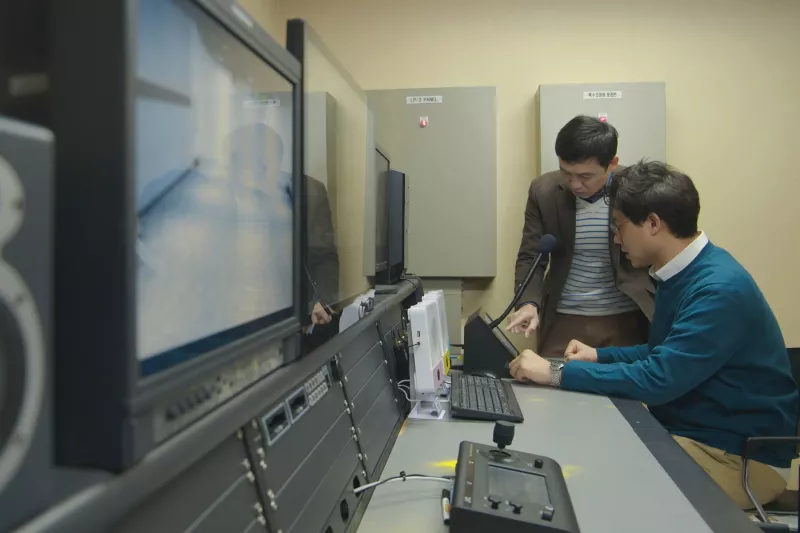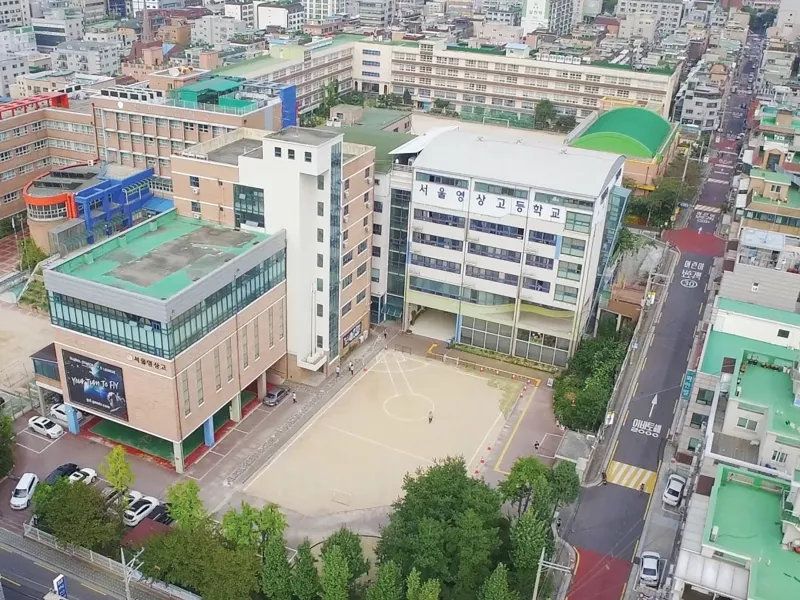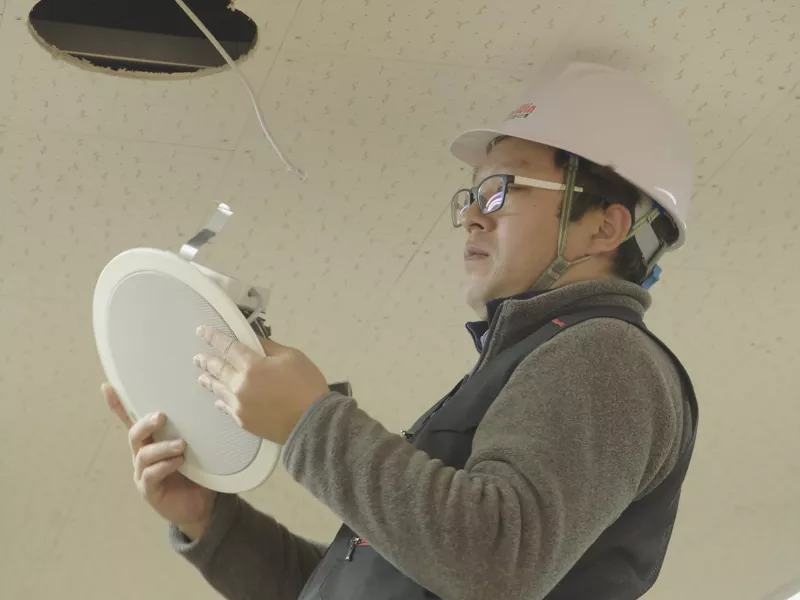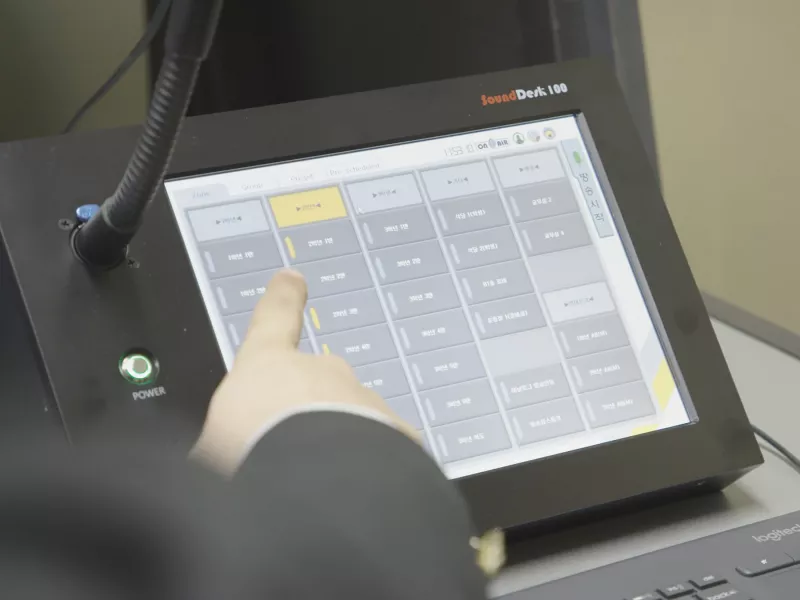
Seoul Visual Media High School benefits from smart, economical Axis network audio.
High-quality broadcasting system complements the school’s reputation.
Mission
Founded in 1952 with the school motto of “Faith, Love, and Gratitude,” Seoul Visual Media High School (SVMHS) was designated as a representative high school for visual media in 2004. SVMHS accommodates approximately 450 students in 6 classes per grade, and it is currently the only school accepting applications nationwide. SVMHS is comprised of three major areas of study—visual contents, visual media, and visual media management, and it strives to develop talents with outstanding creativity in these areas. SVMHS uses its broadcasting system to conduct English listening tests to assess student progress in academic achievement.
However, the outdated, existing analog-based system only provided low-quality sound and limited management functions. This triggered the implementation of a high-quality broadcasting system to promote a learning environment and provide students with a more reliable assessment system.
Solution
SVMHS conducted extensive preliminary research on possible broadcasting solutions related to the reliability of academic progress assessments. Analog-based systems were first considered since the school was familiar with one, but they revealed high implementation costs and limited functional capacity. SVMHS consulted with Darwin System, an Axis partner, and determined Axis’ IP-based audio system would be the best solution to accommodate the school’s limited budget and yet meet all elements required by the school.
Result
SVMHS implemented a highly cost-effective, simple, and efficient broadcasting system by bringing in an Axis network audio system, which enabled a combined system operation. Axis network speakers are all-in-one speakers and support PoE (Power over Ethernet), which allows easy and fast installation and improved sound quality. Students are greatly satisfied with the improved sound quality during listening tests. Audio management system allows an easy and combined operation of the entire system, management of live or scheduled announcement, and transmitting selected audio sources to designated zones through a one-click process.
Students are greatly satisfied with the clear sound Axis’ high-quality network audio system provides. It is our plan to extend the Axis system to additional uses to provide students with an even more enhanced learning environment and optimize management efficiency in the future.
Constraints of existing analog-based system
SVMHS had previously used an analog broadcasting system for sending broadcasts such as announcements and listening tests. With the aging system and copper cables, the school was experiencing low-quality sound and background noise. Space became an issue as various individual devices had to be connected to send broadcasts, all stored in the studio. One of the biggest problems was that the unified broadcasting system could only send one audio source at a time to the entire school, which made it impossible for the school to conduct concurrent listening tests for all grades.

Coupled with the expansion of the school building was the need to extend the broadcasting system. SVMHS decided to implement a high-quality audio system to provide students with a learning environment that complemented the characterization of the school – audiovisual media. Key requirements for a new system included sound quality, enhanced functionality, userfriendly operating system, and easy operation and maintenance.
SVMHS initially contacted companies suggesting analog-based, or analog-digital hybrid broadcasting systems. An analog speaker uses two separate cables for power supply and audio transmission, both of which are connected to an amplifier. An analog speaker also requires an additional purchase of related equipment. Si-kwon Lee, an SVMHS teacher, reflects, “It was an incredibly complex and costly project to install speakers in three school buildings and connect the cables from them to the studio, which could not solve any of the problems we were experiencing.”
Huge cost savings with network audio
SVMHS learned about Axis network audio system while it was searching for the most suitable replacement broadcasting system that could possibly solve the problems the school was experiencing and meet its requirements. The school principal Chul-sik Shin stated, “It was not easy to find a broadcasting system that could satisfy our students, with the school’s limited budget” and “consulting with Darwin System revealed that the total implementation cost of a network broadcasting system was significantly lower than others, and after going through the demo, we selected Axis network audio system for its clear sound and many smart features at an economical price.”

To improve sound quality and enable separate broadcasts by grade, 28 network speakers, including AXIS C1004-E (cabinet), AXIS C2005 (ceiling), and AXIS C3003-E (horn), were installed. To combine the operation with the existing analog speakers, four AXIS C8033 Network Audio Bridges were installed. Darwin System’s independently developed audio management system was also added to the solution to allow user-friendly, combined system management.
Axis network speaker is an all-in-one system combining a mixer, digital signal processer, streaming box, microphone, and power supply unit. It supports PoE (Power over Ethernet), which allows an easy and fast installation using a network cable for supplying power and transmitting audio signals. The total installation cost tends to be less than installing analog speakers, although the cost of speakers themselves may be higher, because no separate equipment is required and the cabling is straight forward. No sound experts are required to install and operate the system, and there is less troubleshooting needed, thereby reducing the Total Cost of Ownership (TCO).
Significant sound improvement
SVMHS achieved upgraded, high-quality school broadcasts by implementing the Axis network audio system. Sound quality is noticeably improved so the audience has access to crystal clear audio broadcasts. The network audio system prevents data loss or noise resulting from cable distance or interference, so the sound quality is identical across the entire school area. Speakers are equipped with built-in auto speaker-test functionality, which allows the user in the studio to confirm that all speakers are functioning appropriately.

Additionally, different from the unified, analog broadcasting system, Axis network audio systems allow sending different audio sources to specified broadcasting zones. By creating zones to address a number of speakers at the same time, it is possible to direct different background music, or live or scheduled announcements. This allows the school to concurrently conduct listening tests with different content for each grade, providing a solution to one of the school’s biggest concerns.
The school principal Chul-sik Shin gave a thumbs up by stating, “I have heard many positive comments about the sound quality of the school’s broadcasts since bringing in Axis’ high-quality network audio system, and students are happy with it.” Shin went on, “It is nice to have a broadcasting system that suits the school’s identity.”
Maximized flexibility and efficiency
The implementation of the Axis network audio system delivered many functions that were previously unavailable. For example, various sound sources can be loaded to the system, and class bells can be scheduled to ring at the beginning and end of each class. Broadcasts are sent to a selected group of speakers by grade or zone to minimize any disturbance to other groups. Groups and schedules can be easily modified. Another helpful feature is that it allows controlling or changing the volume of each speaker either individually or simultaneously. According to Si-kwon Lee, an SVMHS teacher, each classroom and learning room has a different size, meaning the distance between the speakers and students also varies per room, and listeners take advantage of the individual volume setting on Axis speakers to choose the most comfortable level for them.

In addition, different from the traditional way of sending broadcasts from the studio only, the Axis network audio system allows broadcasts to be sent from IP phones or smartphones in other places such as a teachers’ room or the security office. Jae-sung Ryu, the Chief Executive Officer at Darwin System, states, “Besides clear sound, the Axis network audio system is designed to improve operation efficiency by allowing the school to continue using the existing analog speakers while benefiting from the new system’s features.”
Using AXIS C8033 Network Audio Bridge which connects and combines analog and network audio systems, the entire set of broadcasting devices are connected, integrated, and controlled as one single system, and existing analog speakers are available for use of all features through the network system. This may be a game-changer for those looking to protect previous investments and benefit from cost effective features network audios offer.
Improved operation efficiency
The new system improved the operation and maintenance efficiency through the simple installation process and convenience of the combined management of the different devices connected to the system. The new system solved the space issue since only the management server, console, microphones, PoE switch, and three CD players (for grade-level listening tests) are required in the studio. The reduced number of devices and cables also meant reduced risk of system breakdown or unavailability. System expansion is a snap since only additional speakers are required. The system can also interface with other IP systems and devices including cameras and access control systems.
Customized and easy-to-operate
SVMHS added an audio management system (which Darwin has independently developed) to the solution so every aspect of the system can be managed with one, intuitive interface. This system includes the hardware and software needed for system management and is comprised of a management server and user console for central management of device settings for network speakers, analog speakers (connected by audio bridges), and IP phones. Since it is developed to support full features of the Axis network audio system, users can easily set broadcasting zones, manage sound sources, record broadcasting contents, and manage volume and scheduling of broadcasts. Flexibility of customization based on the user’s environment is another benefit of this system.

The audio management system enables the user to define different zones to send broadcasts to either one zone, using an individual speaker, or to all zones. Contents could vary from prerecorded music or announcements to live announcements, from stored music on SD card to music streaming, and it only takes one click to broadcast a selected sound source to the designated broadcasting zone. The system allows the user to view the list of broadcasts at a glance and edit the list as needed to broadcast the right content at the right time to the right place.
Si-kwon Lee, an SVMHS teacher, states “the school needed a new system capable of combining different devices used in school broadcasting. The concept of a network audio system was unfamiliar to us at first; however, we were assured by Axis and Darwin’s professional, in-depth briefing that it was the right solution for the school and took into account the many critical factors involved in making such a decision.”
SVMHS now combines all functionality needed for a broadcasting system into one solution to realize significant cost saving and plans on extending the Axis network audio system to additional uses to optimize management efficiency.
Get in touch
Want to know how you can benefit from Axis solutions? Get in touch and we will help you.
Contact us